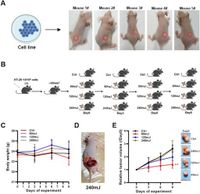Colorectal cancer (CRC) is a prominent global health issue, ranking as the second leading cause of cancer deaths. Standard treatment regimens often involve a combination of surgery, chemotherapy, and radiation; however, many patients face limited options, particularly at advanced disease stages. Recent studies are now exploring innovative therapeutic strategies, with extracorporeal shock wave therapy (ESV) emerging as a promising candidate for CRC treatment.
A recent study published on March 21, 2025, investigates the efficacy of ESV in hampering the growth of CRC tumors. Researchers utilized both in vitro and in vivo models involving the human colorectal cancer cell lines HT29 and SW620, which were introduced into xenograft mouse models to observe the effects of varying shock wave energy levels on tumor proliferation.
The results were striking: while control tumors exhibited a dramatic increase in size of 262.8% within days, mice treated with 60 mJ ESV only saw a 141% growth in tumor volume. Moreover, the treatment posed no adverse effects on body weight or organ function, indicating a safer alternative for CRC therapy.
In contrast, higher ESV dosages (120 mJ and 240 mJ) appeared to lack effectiveness, resulting in 197% and 249.3% tumor growth respectively and showcasing potential vascular lesions in the higher energy group. These findings align with the study’s focus on the potential of low-energy ESV as a safe therapeutic option.
To delve deeper into the mechanisms at play, researchers performed transcriptome analyses of tumor tissues. This revealed that the application of 60 mJ ESV significantly suppressed colorectal cancer cell proliferation by inducing apoptosis and ferroptosis, processes governed by the p53 signaling pathway—often referred to as the 'guardian of the genome' due to its critical role in regulating cell growth and preventing cancer.
According to the study, "Administration of 60 mJ ESV significantly suppressed tumour growth, resulting in growth of only 141% (p < 0.01)." It was also noted that "ESV-treated CRC cells had more cells in the G0/G1 phase (77.3%) than control cells (60.6%)," indicating the therapeutic action of ESV on cell cycle regulation.
Furthermore, apoptosis markers—such as cleaved-PARP and cleaved-caspase3—were upregulated, supporting the notion that ESV can induce cell death mechanisms in CRC. As the authors summarized, "These findings indicate that ESV may exert therapeutic effects by suppressing the proliferation of CRC cells," highlighting the significance of activating the p53 pathway in therapeutic strategies.
The potential for ESV therapy extends beyond CRC, with implications for other tumor types that may benefit from a non-invasive treatment approach. The data implies that treatments leveraging low-dose shock waves could reduce reliance on conventional cancer therapies, which are often accompanied by severe side effects and limited efficacy.
The promising findings of this study open avenues for further research into the clinical applications of ESV therapy in oncology. Given the high incidence of colorectal cancer and the urgency for improved treatment options, ESV represents a compelling adjunct to traditional therapies. Researchers are hopeful that forthcoming studies involving spontaneous CRC models may validate these initial results and broaden the scope of shock wave therapy in cancer treatment.
In conclusion, the exploratory nature of this study and its findings underscore the urgent need for innovative therapeutic approaches in combating colorectal cancer. ESV not only inhibited tumor growth significantly but also did so through important biological mechanisms that warrant deeper investigation.
Future research endeavors will be crucial in determining the effectiveness of ESV therapy in clinical settings, including potential integration with existing treatment modalities for comprehensive cancer care.

